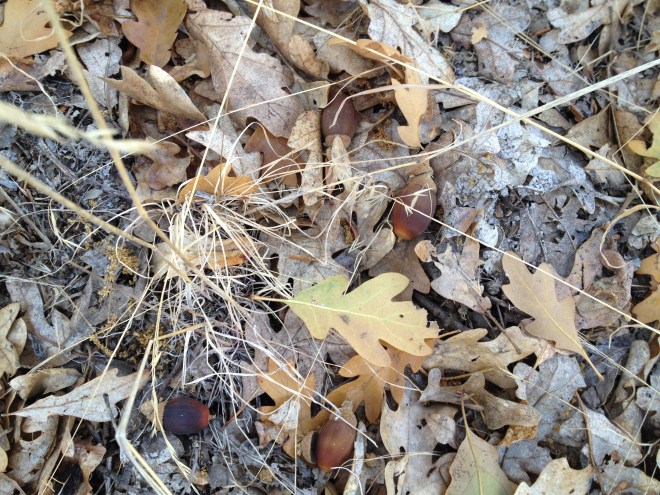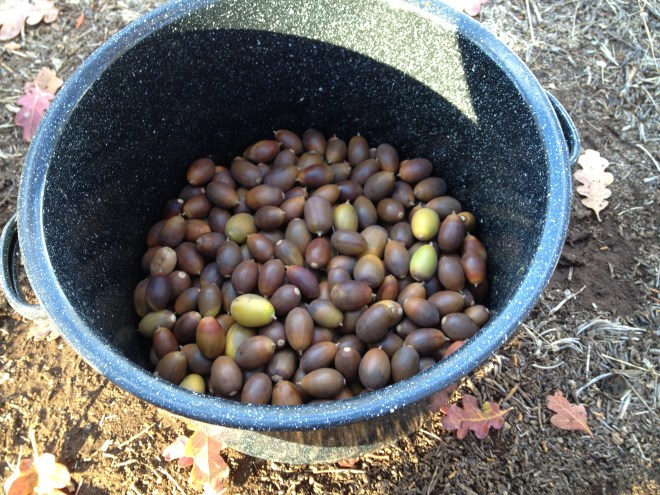I managed to escape the city and head up to Serenity Valley for Halloween weekend, which was a real treat. Autumn is one of my favorite seasons up in the mountains, with the beautiful colors, the damp smell of the woods, and perfect 75-degree weather. And this most recent trip also turned out to be a quite productive one to boot…
On Saturday, I was walking down the dirt road to go visit my neighbor, when I stopped dead in my tracks. What did I see? Acorns! And tons of them. Now, with hundreds, maybe thousands, of Oregon White Oak on my property, you’d think it’d take more than the sight of acorns to get me excited. But, the truth is, I haven’t noticed very many acorns in the past. Sure, I’d see maybe a few worm-holed and mildewy acorns here and there, but I’d never seen shiny plump acorns littering the ground the way I saw this time.
So, I did what any sensible member of a hunter-gatherer species would do: I started gathering. I’d heard that Native Americans ate acorns, and with not much else on my property that’s edible, I was excited to finally come across a native edible crop.
As I filled my bag with these shiny orbs, giddy as a kid on Halloween, I started wondering: why haven’t I seem so many acorns in the past? And why so many acorns under this one particular tree? None of the trees neighboring this one tree by the dirt road had any significant number of acorns under them. Odd…
I stood up, stretched my back, and pulled out my iPhone to do some research. As it turns out, oak trees don’t start producing acorns until they are 20 – 50 years old. Many of the trees on my property are small and skinny, and might not be that old yet. Additionally, it could take trees 2 years or more to save up enough energy to produce acorns, and that’s assuming a late frost doesn’t destroy all the buds. Indeed, further exploration of my property confirmed that while not all of my oak trees had acorns, many of the larger ones did.
Within an hour or two of casual gathering, I had collected several pounds of acorns. But what exactly are they good for? Well, on their own, not much. I cracked open one of the acorns, and the nut inside looked juicy and inviting. Of course, a small nibble confirmed what I already knew: they’re mouth-puckering-ly bitter. I also tried roasting some on my wood stove, which made them edible, but just barely and only if I were desperate. To get rid of the bitterness, they need to be leached with water. It appears the easiest way to leach them is by first crushing them into acorn meal, then repeatedly soaking and straining them until all the bitterness is gone. You can then dry the meal over a fire or in an oven. The resulting acorn meal can be consumed as-is, or can be milled into flour and used for baking.
So, as far as edible crops go, acorns aren’t exactly the easiest to consume. But, I could see how they could be useful as a food source nonetheless, simply because of their abundance and ease in gathering, as well as their (presumably) high caloric content. They apparently don’t keep very well due to their high fat content, but I could see an autumn harvest of acorns lasting through the cold winter, and providing valuable calories during those lean months. It’s also exciting to know that if I grew some corn, I could use corn meal and acorn flour to make bread, without “importing” flour.
***
The other big news is that, my neighbor came up to help, and we (finally) got the rest of the cement board siding up! As far as I’m concerned, the exterior siding is mostly aesthetic, though it’s definitely more fire resistant than the previously exposed insulation boards, quite weatherproof, possibly somewhat insulating, and it might add a bit of rigidity to the structure, so it’s good to have them up. There’s still some parts that are exposed, so I need to cover those bits up, then put trims on the corners and around the windows, paint the whole thing, and I’ll finally be able to call it done. It’s a project that’s been 2 years (and counting) in the making, but it still feels good to make progress…
Anyway, I’ll let the pictures tell the rest of the story:







